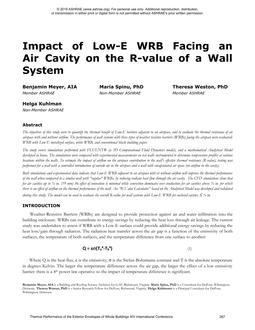
Impact of Low-E WRB Facing an Air Cavity on the R-value of a Wall System
Click here to purchase
The objectives of this study were to quantify the thermal benefit of Low-E barriers adjacent to an airspace, and to evaluate the thermal resistance of an airspace with and without airflow. The performance of wall systems with three types of weather resistive barriers (WRBs) facing the airspace were evaluated: WRB with Low-E metalized surface, white WRB, and conventional black building paper. The study covers simulations performed with FLUENT® (a 3D Computational Fluid Dynamics model), and a mathematical Analytical Model developed in house. The simulations were compared with experimental measurements on test walls instrumented to determine temperature profiles at various locations within the walls. To estimate the impact of airflow on the airspace contribution to the wall’s effective thermal resistance (R-value), testing was performed for a wall with a controlled introduction of outside air in the airspace and a wall with encapsulated air space (no airflow in the cavity). Both simulations and experimental data indicate that Low-E WRB adjacent to an airspace with or without airflow will improve the thermal performance of the wall when compared to a similar wall with “regular” WRBs, by reducing radiant heat flow through the air cavity. The CFD simulations show that for air cavities up to ¾ in. (19 mm) the effect of convection is minimal while convection dominates over conduction for air cavities above ¾ in. for which there is an effect of airflow on the thermal performance of the wall. An “R-Value Calculator” based on the Analytical Model was developed and validated during this study. The model can be used to evaluate the overall R-value for wall systems with Low-E WRB for enclosed cavities – ¾ in.
Citation: Thermal Buildings XIV 2019
Product Details
- Published:
- 2019
- Number of Pages:
- 9
- Units of Measure:
- Dual
- File Size:
- 1 file , 2.3 MB
- Product Code(s):
- D-Bldgs19-029


